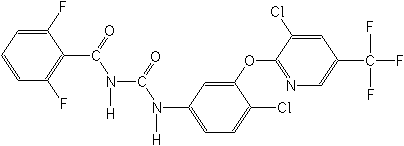|
Return
to Fluazuron
Index Page
Activity:
Acaricide
(benzoylphenyl urea)
Structure:

•
Note: As there is little data available on Fluazuron, we include
the following.
The northern fowl mite, Ornithonyssus sylviarum,
is the major ectoparasite of poultry flocks in Ontario and
North America causing millions of dollars in damage to the
industry (est. $2M for Ontario). Traditionally, northern
fowl mites have been controlled using a variety of dermally
applied acaricides. The efficacy of the experimental systemic
acaricide, Fluazuron® (CGA 157419)
to control northern fowl mites on chickens was determined.
Fluazuron® effectively eliminated mite populations on
infested birds when administered at 10 mg active ingredient
per kilogram of body weight. Although mite populations declined
on birds treated repeatedly with 1 or 3 mg of Fluazuron®
per kg of body weight, birds treated at these dosages remained
infested. Based on analysis of mite population age structure
and percent hatch of deposited eggs, the mode of action
of Fluazuron® on mites was unclear. Fluazuron®
residues could be measured in adipose up to 123 days following
treatment with 10 mg/kg and trace amounts of the drug were
consistently observed in breast meat up to 30 days after
treatment. Thus unless the legal tolerance for Fluazuron®
residues in selected tissues are modified, this product
has little chance of registration for control of northern
fowl mites, despite its observed efficacy against these
ectoparasites.
Ref: Ontario
Agriculture, Food, and Rural Affairs (Canada)Research Projects
Summary. FOOD SYSTEMS 2002 - PEST MANAGEMENT RESEARCH PROGRAM.
*FS7143 - Evaluation of the Benzoylphenyl Urea, Lufenuron7
for Control of the Northern Fowl Mite, Ornithonyssus Sylviarum
http://www.fluorideaction.org/pesticides/lufenuron.residues.canada.htm
|
Brain
(click on for all fluorinated pesticides)
Cattle
Oral application of 2.0 mg/kg b.w. of fluazuron gives rise to
more rapid absorption and maintains higher level of fluazuron
in the bloodstream of cattle than a dermal treatment at the same
dose level (Bull and Strong, 1994). The
compound distributed to the tissues such as muscle, kidney,
liver, lung and brain but deposited
preferentially in the fat. When the radiolabelled fluazuron was
administered subcutaneously to cattles at 1.5 mg/kg b.w., the
mean maximum plasma level of total radioactivity was reached in
48 hours post dose. The radioactivity was absorbed slowly from
the site of injection. Half life of the radioactivity in the blood
was around 78 days (Cameron, B.D., Somers, K. and Speirs, G.C.
(1992). The Distribution and Excretion of [U-14C]Cl-Phenyl CGA
157419 after Subcutaneous Injection to Cattle. Unpublished report
No. 141232. Inveresk Research International Limited, Tranent,
Scotland. Submitted to JECFA by Ciba-Geigy Limited, Basle, Switzerland.)
Ref: Fluazuron. UN Food and Agriculture
Organization. First draft prepared by Dr. P. S. Tantiyaswasdikul,
Department of Pharmacology, Faculty of Pharmaceutical Sciences
Chulalongkorn University, Bangkok, Thailand.
http://www.fao.org/docrep/w8338e/w8338e09.htm#fluazuron
|